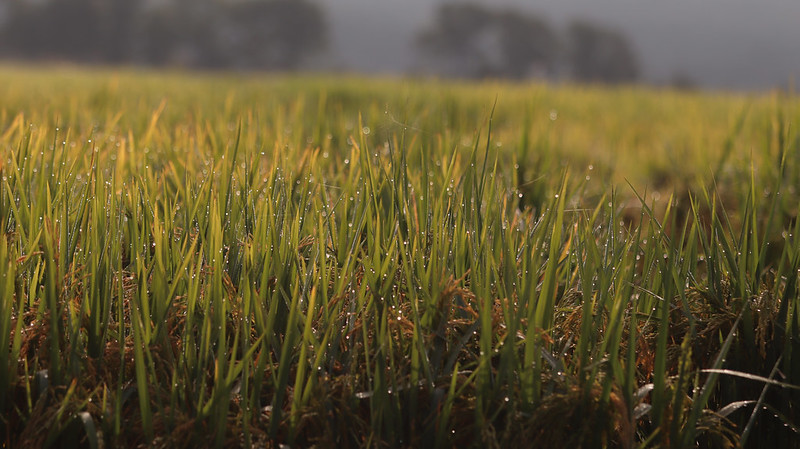In stops and starts, Arkansas rice planting advances
May 12, 2025
By Ryan McGeeney
U of A System Division of Agriculture
Fast Facts:
- Arkansas rice growers still rebounding from April weather events
- Periodic rains, limited seed supply affecting efforts
(458 words)
(Newsrooms: download file art)
LITTLE ROCK — Every growing season brings its own unique challenges to Arkansas farmers, and the spring of 2025 is no exception.
By the time the massive storm system of early April swept across Arkansas, the state’s growers had already planted at least 15 percent of the state’s estimated 1.4 million planned acres of rice. The storm’s associated rainfall — more than 10 inches in some areas — and the flooding that followed wiped out an approximated 50,000 acres of that early planted rice.
While Arkansas farmers are no strangers to replanting after such a setback, the subsequent, near-weekly rain events over the following month have made the effort extraordinarily slow going, said Jarrod Hardke, extension rice agronomist for the University of Arkansas System Division of Agriculture.
“We’re in this cycle of getting rain every seven days or so,” Hardke said. “That makes it impossible, even on our lighter-draining soils, to get any planting done. If you get a 1-inch rain on Monday, it’s going to be potentially four to five days before it’s dry enough to do anything.
“Maybe you get one or two days to work before the next rain event,” he said. “It takes a lot of effort to get geared up to roll. You waste half of the first day trying to get in gear, and half the second day trying to wind down and get to a stopping point.”
Hardke said that in addition to the 50,000 acres of lost planting, a similar number of acres will require some degree of levee repair as well.
“There’s also the matter of acres under water that hadn’t been planted yet,” Hardke said.
“It’s a bigger impact than we know yet.”
Herbicide impacts
The intermittent rain events have also impacted the effectiveness of the residual
herbicides growers typically use to control weeds during this part of the season.
“Residuals did so well last year because we kept getting these small rains — about every five to seven days for six weeks, reactivating the chemicals without washing them away,” Hardke said. “But this year it’s just been heavy rains. It’s a different situation, and we’re struggling with slower rice emergence and some weeds breaking through.”
Keeping what we’ve got
The limited supply of long-grain rice seed has affected growers’ efforts to plant or replant, Hardke said.
“We’ve still been struggling with progress and uniformity of a lot of that rice,” he said. “We’re looking at keeping a lot of stands that are poorer than what we’d typically keep, partly because of the weather and partly because of the seed supply situation. Given the right weather and better seed availability, we might’ve done more replanting. But given the situation we’re in, we’re keeping what we’ve got and doing the best we can.”
To learn about extension programs in Arkansas, contact your local Cooperative Extension Service agent or visit www.uaex.uada.edu. Follow us on X and Instagram at @AR_Extension. To learn more about Division of Agriculture research, visit the Arkansas Agricultural Experiment Station website: https://aaes.uada.edu/. Follow on X at @ArkAgResearch. To learn more about the Division of Agriculture, visit https://uada.edu/. Follow us on X at @AgInArk.
About the Division of Agriculture
The University of Arkansas System Division of Agriculture’s mission is to strengthen agriculture, communities, and families by connecting trusted research to the adoption of best practices. Through the Agricultural Experiment Station and the Cooperative Extension Service, the Division of Agriculture conducts research and extension work within the nation’s historic land grant education system.
The Division of Agriculture is one of 20 entities within the University of Arkansas System. It has offices in all 75 counties in Arkansas and faculty on three campuses.
Pursuant to 7 CFR § 15.3, the University of Arkansas System Division of Agriculture offers all its Extension and Research programs and services (including employment) without regard to race, color, sex, national origin, religion, age, disability, marital or veteran status, genetic information, sexual preference, pregnancy or any other legally protected status, and is an equal opportunity institution.
# # #
Media Contact:
Ryan McGeeney
rmcgeeney@uada.edu
@Ryan_McG44
501-671-2120
